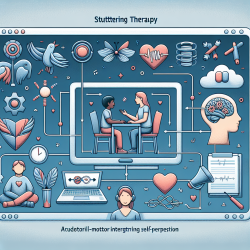Introduction
In the realm of speech-language pathology, leveraging data-driven approaches to improve therapeutic outcomes for children is crucial. A recent systematic review titled "Virtual Mindfulness Interventions to Promote Well-being in Adults: A Mixed-Methods Systematic Review" offers insightful findings that can be adapted to enhance child therapy practices. This blog explores how these findings can be applied in a virtual setting to benefit children's emotional and cognitive development.
Understanding the Research
The systematic review conducted by Xu et al. (2022) analyzed various mindfulness-based interventions (MBIs) and their impact on well-being. The study focused on adults but provides a framework that can be adapted for children. The research highlights the efficacy of programs such as Mindfulness-Based Stress Reduction (MBSR), Mindfulness-Based Cognitive Therapy (MBCT), and the Learning 2 BREATHE (L2B) program in improving mental health outcomes.
Applying Mindfulness Interventions in Child Therapy
While the original study targeted adults, the core principles of mindfulness can be tailored to suit children's developmental stages. Here are some strategies:
- Basic Mindfulness Techniques: Introduce simple mindfulness exercises such as deep breathing, body scans, and guided imagery to help children focus and manage stress.
- Mindfulness-Based Stress Reduction (MBSR): Adapt the MBSR program to include child-friendly activities like mindful coloring and nature walks, which can help reduce anxiety and improve concentration.
- Learning 2 BREATHE (L2B): Implement the L2B program with modifications to teach children about emotional regulation through playful activities and storytelling.
Benefits of Virtual Mindfulness Interventions
Implementing mindfulness interventions virtually offers several advantages, especially in the context of online therapy services like those provided by TinyEYE:
- Accessibility: Virtual platforms make mindfulness practices accessible to children regardless of geographical location.
- Flexibility: Online sessions can be scheduled at convenient times, allowing for consistent practice.
- Engagement: Interactive digital tools can enhance engagement and make mindfulness exercises more appealing to children.
Encouraging Further Research
While the current research provides a solid foundation, further studies focusing on children are essential. Practitioners are encouraged to explore the following areas:
- Longitudinal Studies: Investigate the long-term effects of mindfulness interventions on children's emotional and cognitive development.
- Customized Programs: Develop and test mindfulness programs specifically designed for different age groups and developmental stages.
- Technology Integration: Explore innovative ways to integrate technology into mindfulness practices to enhance effectiveness and engagement.
Conclusion
Integrating virtual mindfulness interventions into child therapy can significantly enhance emotional regulation and cognitive outcomes. By adapting the strategies outlined in the systematic review, practitioners can create a supportive environment that fosters well-being and resilience in children.
To read the original research paper, please follow this link: Virtual mindfulness interventions to promote well-being in adults: A mixed-methods systematic review.










